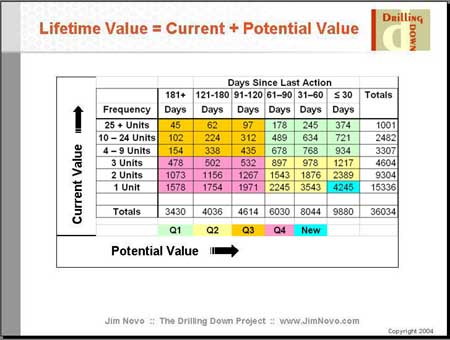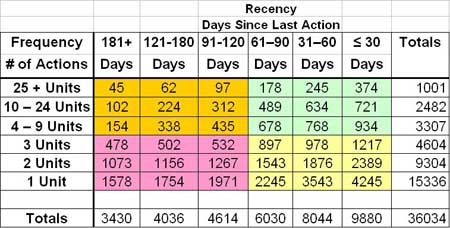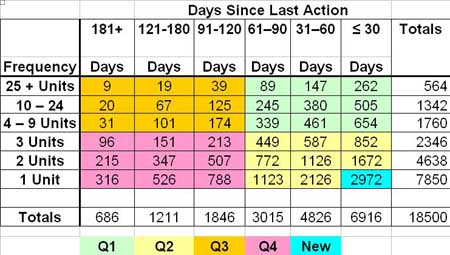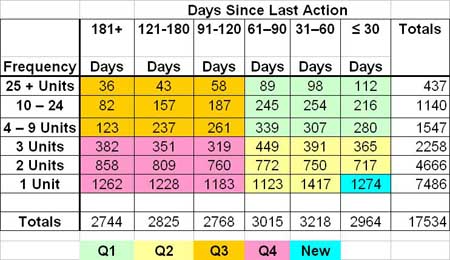A list of the posts in this series on Brand Management is here.
Without getting too deeply into the Math (and if you wish to, feel free to post) the web simply does not have the “weight” to move the needle like TV does. It ends up our ol’ offline advertising friend GRP’s (Gross Ratings Points = Reach x Frequency) mean something. But “you can’t measure the web that way” has always been the cry from online Display ad proponents. Yea, no kidding.
This from ARF’s Online Reach & Frequency Committee:
“When a banner or other type of ad is served, it is rarely exposed to the full audience of the site or even the full audience of the page served. As a result, there is no relationship between the site’s audience and the audience for the advertising.”
Hmm. Houston? That’s what you call a problem in media, a problem that makes any criticism of the GRP / TRP way of life simply slide off the radar. Christ, at least with GRP’s we have some kind of yardstick, some tangible notion of “weight”, however inaccurate. At least GRP’s are consistent, which I can deal with. We used to worry about frequency imbalances, you know, over / under delivery on Frequency to certain segments. Or, sure, people get up and go to the bathroom during the ad or use a VCR and skip the ads. That’s all nothing compared to this little online problem we have here with Display Advertising and audience measurement. Perhaps we’re just going about this whole Display Ad thing in the wrong way, trying to force an old media business model into a new media environment?
In 1991 when I was at HSN, we actually tried to convince Nielsen to measure the HSN TV audience in Cume Quarter Hours. They went right over the edge. “That’s a radio measurement” they sneered, like I didn’t know. “Why is radio measured differently than TV?” I asked, feigning innocence. “Because radio listeners behave differently than TV viewers”, they said. Oh, I see. So audience behavior defines best practices for audience measurement? Cool beans, man. I’m with ya.
Because, you see, my pointy-headed little Nielsen-ites, the way people primarily watch TV Shopping is by flipping into and out of the shopping program while they are watching something else on TV – something else you folks, by the way, are assuming they are watching straight through. Lots of people, for example, flip to HSN during the ads on the other TV Networks. The behavior is different, it’s a lot more like radio where people are constantly changing stations, which is why radio uses Cume Quarter Hours, right?
Silence from the Nielsen-ites.
Then, “We’ll get back to you on this”. They never did. Wouldn’t even take my calls. I think they were hoping TV Shopping would just go away. Meanwhile, a TV network that supposedly had “no viewers” sold a billion dollars worth of stuff that year.
No viewers, indeed.
I think you can probably see where I am headed with this. But I’m not letting you off the hook yet.
I may be the only one reading this old enough to remember the launch of cable television. Yes, there was a time when there was no cable TV. Back then, our friends at Nielsen operated strictly with the diary system, and surprise, surprise, cable TV never got any ratings. No viewers. Years and years of lobbying later – with the broadcast networks doing everything they could to pressure Nielsen into sticking with the diaries -Nielsen installed the meter system. For the first time, you could actually tell what TV channel people were tuned to. And the ratings for cable TV absolutely exploded off the charts. The trade pubs were all “Who knew?” and all the major agencies were “Mea culpa!” as they dove in head first and spent billions on cable network advertising. Good thing to, because a lot of those early cable networks were on the verge of going belly-up. Not too many years later, total cable programming viewership exceeded total “broadcast” programming viewership for the first time.
No viewers, indeed. Ends up people were doing a lot of “flipping” with that new-fangled remote control thing that came with the cable box. Yes, flipping. From channel to channel. Can you imagine it? Viewers don’t sit still and watch the entire program through to the end? And you mean to tell me viewers wouldn’t spend the time to write every flip down in a diary? Or remember every flip in the end of the month rush to fill out the diary from memory? C’mon, who knew?
So now we get to online display ads, and we’re back in Houston again (with apologies to those of you who live in Houston – a great city). The onliners are simply not measuring this audience stuff correctly or not measuring it at all, depending on your point of view. And the end result is Online Display ads simply don’t work as “mass media”, you can’t get any “weight”, so you can’t move the needle at the checkout aisle for a Brand Manager.
Based on past experience, I’d have to say this: the behavior of the audience probably has something to do with this measurement problem. Call me crazy. But the fact of the matter is advertisers want to understand the audience for a media, and once they do, they’re pretty likely to jump in with both feet, just like they did into cable TV when they got the measurement right. Unless, of course, the measurement indicates Online Display ads are basically equivalent to advertising on matchbook covers in terms of any mass-media “weight” you can get.
If you’re looking for an answer to this particular online display advertising measurement problem as it stands today from me, I’m not that smart. There are plenty of people with deeply vested interests in this area to chase down the “right” answer if the Display industry chooses to stick to the old media model.
But may I suggest that this answer will not be found in an “old media” model. I think it’s possible that because of the extreme fragmentation in this online media, you simply can’t get to any kind of measurement that makes sense from the old model mass media perspective. The closest you can get to an old media idea is the “Yahoo HomePage Takeover” kind of trick, where you basically know what visits to the HomePage will be and you have a single “forced” point source for the ad. Now you’re getting closer to a GRP-feeling kind of measurement, if you exclude robots and all the pingers and everything else that’s not human.
That still doesn’t take into account the behavior side, the fact that most folks on the web are there to get something done in one way or another, not to sit passively being entertained. So unless what your ad has to say is directly related to the task at hand, it simply isn’t going to make a difference, if it even registers as an impression. Most of this display advertising has been so irrelevant to the visitor for so long that people don’t even see the ads any more.
At this point, I bet you think my opinion of banner real estate is that it’s useless. That’s not the case. I think the way this space is currently packaged, used, and measured is illogical and defies what we know about human behavior. I also think there’s a pretty good chance you can never aggregate enough exposure to this space to create “weight” comparable to mass media, or that if you can do this aggregation, the expense of doing so drives the cost of the media beyond what it costs to do the same job – with a lot less pain – on TV.
I mean, that’s the underlying problem, the real root cause, right? At some point, when you’re trying to create a “mass media weight” in a totally fragmented environment like the web, the expense of not just the media but the damn administration of it gets so high you might as well go out and buy yourself a basket full of TV and Radio. Which is exactly what the Brand folks do.
Sure, you can do some highly targeted Display stuff that works out pretty well, filling in against “lost audiences” and so forth, and there are examples of this approach around. But let’s agree this kind of execution is not “mass media” by any stretch of the imagination, OK?
So Jim, what would you do with the banner space to make it worth purchasing by mass media folks? Reject the offline mass-media model, and create a behaviorally appropriate model for online Display, one that directly and effectively supports offline mass media as opposed to trying to be the offline mass media.
I would stop trying to turn the banners themselves into “mass media”; stop worrying about awareness and intent and all that stuff based on the Banner alone. Instead, use banners to bring people to a microsite / web site, where they can be delivered a tangible experience of some kind. Then run these packages underneath the mass media: use the mass media to do what it is good at – generate broad awareness. Let the banner / site package come in behind and take care of the intent and engagement. The proper execution of this idea is as a TV –> Banner –> Microsite integrated campaign – I’m not talking about just slapping a URL on a TV ad here.
And then look at your awareness and intent – not based on the Banners alone, but on the interaction of visitors with the banners and the web site as a package. This would be a new media approach to the new media, as opposed to trying to force the old display model into new media.
By taking this approach, you align yourself with the behavior of the consumer, and slash out a tremendous amount of noise on the measurement side. The measurement population becomes “Of those who are interested enough to click the banner” versus “Of those who we continue to bludgeon to death with irrelevant advertising”. To help people get their heads around this, the closest offline compare is probably Magazines, where the audience has pre-selected themselves as being interested in a topic and the ads are more like part of the content rather than an intrusion. This is roughly the way the behavior would play out online for a Display / micro-site package.
This approach would require agencies to go “beyond the banner”, and we know it’s not cool for agencies to care about what happens “after the impression“, despite what is going on in their space.
So, 3% of the mass-media budget is OK with you agency folks, then?
Next time: Let’s talk a little bit about what a Brand and Brand Advertising really are, leading to why a banner / site package might make a lot of sense to the mass-media folks controlling the other 97% of the spend. The next post is this series is here.
As always, comments on the above are welcome!



